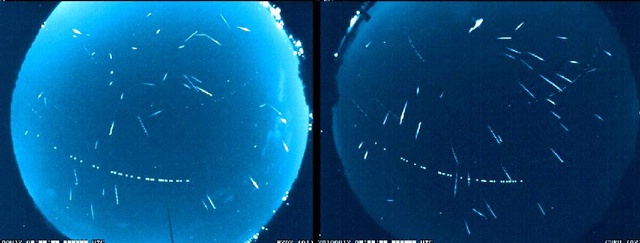
The Perseids Are Coming!
Aug 04, 2011
By Dr. Steven H. Williams is the chief of education initiatives in the Education Division of the National Air and Space Museum
The Perseids are coming! The most consistently best meteor shower of the year, the “Perseids,” (PER-see-ids) will reach their peak next week. The earliest arrivals start around August 7 and the final stragglers show up about two weeks later, but the shower peaks strongly in the August 11-13 timeframe. At the peak, as many as 60 or more Perseids might be seen in an hour, under favorable observing conditions; in 2011 the observed peak rate should be about half that, due to moonlight. Meteor showers occur when the Earth encounters a stream of debris shed by a passing comet or asteroid. The high speed of the material results in a lot of friction, making the debris particles glow brightly, like the filament of an old-fashioned light bulb. Periodic comet 109P Swift-Tuttle is the source of the material causing the Perseid meteor shower.

Route 66. The parallel lines of the road appear to converge on a single vanishing point in the center of the photograph.
Material released along a comet’s orbit is moving in more-or-less parallel paths when the Earth's atmosphere is encountered. Artists and drafts-persons are quite familiar with the "vanishing point" perspective created by looking among and along parallel lines. In the photo below, the road side lines appear to converge on the horizon due to this effect; any objects approaching the observer along those lines would appear to be moving on a radial path with respect to that vanishing point. A similar case of apparent radial motion arises when the Earth encounters the Swift-Tuttle debris stream every year in mid-August. The meteors produced appear to radiate from a point in the sky in the constellation Perseus (named for the mythological Greek hero who slew the Gorgon Medusa amongst other exploits). Meteor showers are named for the constellations in which their radiants reside, hence the upcoming shower is known as the Perseids. Here is a diagram showing this radial pattern for the Perseids. It can also be seen in the photograph of a Perseid shower below (somewhat distorted by the camera).

This image shows two composite views taken on the night of Aug. 11, 2010. The image on the left shows a collection of observations taken from 42 single station events over Huntsville, Ala. The image on the right shows a composite view from 39 single station events over Chickamauga, Ga. Courtesy of NASA/MSFC/D. Moser, NASA's Meteoroid Environment Office
The best way to see Perseid meteors is to look at or near the constellation Perseus in the sky, on or near the date Earth encounters the debris stream. In general, meteor viewing is best in the wee hours of the morning. Just as your front windshield collects more bugs than the back window, the leading side of the Earth collects more meteors than the trailing side, and from the orbit and rotational orientation of the Earth, that means that the best time for meteors is between local midnight and noon, and, since we want to observe at night, that means between midnight and a couple of hours before morning twilight begins. Perseus rises above the NE horizon around 9 PM EDT (at Washington, D.C.’s latitude, ~37°). By midnight, it will be well above the ENE horizon, and will be favorably placed for post-midnight viewing. Find Perseus by using the Big Dipper. One can find the North Star by extending a line from the “pointers,” the two stars at the end of the Dipper’s bowl, in the direction the bend in the Dipper’s handle points. You can find bright star, Capella, by extending a line atop the bowl of the Dipper away from its handle. Perseus is reached by “splitting the difference” between Polaris and Capella, about the same distance from the Dipper. Look between Capella and the “W” shape of the constellation Cassiopeia. Alas, in 2011, the peak viewing time, the night of August 12/13, will also be a time of the August Full Moon (aka “Moon of the Green Corn”). Moonlight will blank out the fainter Perseids, thereby reducing significantly the number of meteors expected to be visible. For additional observing tips, visit the Sky and Telescope website.
Related Topics
You may also like

We rely on the generous support of donors, sponsors, members, and other benefactors to share the history and impact of aviation and spaceflight, educate the public, and inspire future generations. With your help, we can continue to preserve and safeguard the world’s most comprehensive collection of artifacts representing the great achievements of flight and space exploration.
Support the Museum
We rely on the generous support of donors, sponsors, members, and other benefactors to share the history and impact of aviation and spaceflight, educate the public, and inspire future generations. With your help, we can continue to preserve and safeguard the world’s most comprehensive collection of artifacts representing the great achievements of flight and space exploration.

